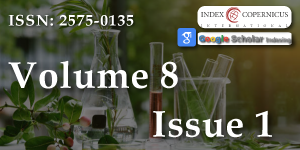Declaration of Fumonisin as the Main Dangerous Mycotoxin Produced by Fusarium Species on Maize in Iran
Main Article Content
Abstract
Our study showed Fusarium spp. can be the most important fungal pathogen of maize causing severe yield losses and producing fumonisins that concern human and animal damages. Actually, other mycotoxins such as aflatoxin contamination have become regular in maize but the appearance of fumonisins was more frequent. However, the fluctuation between years and regions can affect the severity of the infection and then fumonisin production level. This mycotoxin was defined as fumonisin B1, fumonisin B2 and fumonisin B3 with diverse actions. The level of production, concentrations, and damages of fumonisins were found in different locations of maize fields in Iran. However, the fumonisin contents of the isolated samples were more diverse than in other locations. Toxin composition and maximum values differ significantly throughout the climate conditions and maize cultivars. The resistance cultivar of maize against the Fusarium pathogen can be helpful in controlling fumonisin production on the field effectively.
Article Details
Copyright (c) 2024 Saremi H.

This work is licensed under a Creative Commons Attribution 4.0 International License.
The Journal of Plant Science and Phytopathology is committed in making it easier for people to share and build upon the work of others while maintaining consistency with the rules of copyright. In order to use the Open Access paradigm to the maximum extent in true terms as free of charge online access along with usage right, we grant usage rights through the use of specific Creative Commons license.
License: Copyright © 2017 - 2025 |  Open Access by Journal of Plant Science and Phytopathology is licensed under a Creative Commons Attribution 4.0 International License. Based on a work at Heighten Science Publications Inc.
Open Access by Journal of Plant Science and Phytopathology is licensed under a Creative Commons Attribution 4.0 International License. Based on a work at Heighten Science Publications Inc.
With this license, the authors are allowed that after publishing with the journal, they can share their research by posting a free draft copy of their article to any repository or website.
Compliance 'CC BY' license helps in:
| Permission to read and download | ✓ |
| Permission to display in a repository | ✓ |
| Permission to translate | ✓ |
| Commercial uses of manuscript | ✓ |
'CC' stands for Creative Commons license. 'BY' symbolizes that users have provided attribution to the creator that the published manuscripts can be used or shared. This license allows for redistribution, commercial and non-commercial, as long as it is passed along unchanged and in whole, with credit to the author.
Please take in notification that Creative Commons user licenses are non-revocable. We recommend authors to check if their funding body requires a specific license.
Fallahi M, Saremi H, Javan-Nikkhah M, Somma S, Miriam Haidukowski M, Logrieco AF, Moretti A. Isolation, Molecular Identification and Mycotoxin Profile of Fusarium Species Isolated from Maize Kernels in Iran Toxins (Basel). 2019; 11(5): 297.
Leslie JF, Summerell BA. The fusarium laboratory manual (1st ed). Blackwell Pub. 2006; 13.
Saremi H, Okhovvat SM. Mycotoxin producing Fusarium species associated with plant disease on potato, wheat, corn and animal diseases in northwest Iran. Commun Agric Appl Biol Sci. 2006;71(3 Pt B):1175-85. PMID: 17390876.
D’mello JPF. Contaminants and toxins in animal feeds. In: Assessing Quality and Safety of Animal Feeds. Rome: Food and Agriculture Organization of the United Nations. 2004; 107-128.
Santin E. Mould growth and mycotoxin production. In: Diaz DE, editor. The Mycotoxin Blue Book. Nottingham, UK: Nottingham University Press. 2005; 225-234.
Gashaw M. Review on Mycotoxins in Feeds: Implications to Livestock and human health. E3 Journal of Agricultural Research and Development. 2015; 5:137-0144.
Whitaker TB, Slate AB, Johansson AS. Sampling feeds for mycotoxin analysis. In: Diaz DE, editor. The Mycotoxin Blue Book. Nottingham, UK: Nottingham University Press. 2005; 1-23.
Zhang K. Evaluation of Automated Sample Preparation for Mycotoxin Analysis in Foods. J AOAC Int. 2020 Jul 1;103(4):1052-1059. doi: 10.1093/jaoacint/qsz044. PMID: 33241335.
Alberts JF, Van Zyl WH, Gelderblom WCA. Biologically Based Methods for Control of Fumonisin-Producing Fusarium Species and Reduction of the Fumonisins. Front Microbiol. 2016; 7: 548.
Davoudi Z, Saremi H, Ahmadzadeh M, Malihipour A. Effectives of Bacillus velezensis UTB96 on reduction of zearalenone produced by Fusarium graminearum isolated from wheat. Iranian Journal of Plant Protection Science. 2020; 51.
Schaafsma AW, Hooker DC. Climatic models to predict occurrence of Fusarium toxins in wheat and maize. Int J Food Microbiol. 2007 Oct 20;119(1-2):116-25. doi: 10.1016/j.ijfoodmicro.2007.08.006. Epub 2007 Aug 19. PMID: 17900733.

